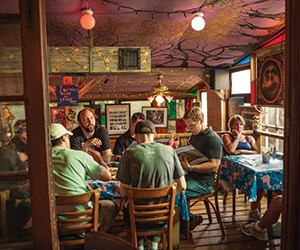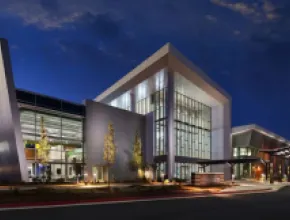Though many feel that “New Orleans” and “French Quarter” always belong in the same breath, the Crescent City’s oldest neighborhood may not even be its trendiest.
That distinction likely goes to a handful of eclectic enclaves–including Faubourg Marigny and Bywater–whose restaurants and shops have long been appreciated by locals but are now being discovered by visitors.
“Many of these neighborhoods are increasing in popularity among meeting planners and groups who want to experience the more authentic parts of New Orleans,” says Cara Banasch, vice president of convention sales and strategy for the New Orleans CVB. “The trend is toward more organic experiences and seeing the destination the way the locals do.”
For many, that means exploring by foot–New Orleans’ compact character makes that a big, easy choice–as well as by pedicab, bicycle and guided tour, with streetcar travel always a desired option.
No matter how you get there, it’s well worth venturing beyond the Quarter to drink in local culture and, yes, great food and drink.
“We’re coming up on the 10th anniversary of Katrina and we’ve rebuilt and reimagined the city,” says Kristian Sonnier, the CVB’s vice president of communications and public relations. “People realized how close they came to losing everything, and they’re refocused on neighborhoods. You’ve got more accessibility, more tours and more civic involvement now; people are eager to show off their neighborhoods.”
Almost as eager as visitors are to see them. Following are a just few of these emerging areas.
Faubourg Marigny
Set “on the cusp of the French Quarter,” as Cara Banasch puts it, Faubourg Marigny is bisected by Frenchmen Street, the main drag known as the local answer to Bourbon Street and where music, especially jazz, rules the day and night.
“Frenchmen Street means music,” declares Lisa Suarez, president of the Faubourg Marigny Improvement Association, pointing to clubs like Snug Harbor and Blue Nile as musts for music lovers. “The Maison is another great place… they open at four and start the music right away. Late at night they switch to modern funk, which is something else New Orleans is known for.”
A number of art galleries also line Frenchmen Street, while art and music converge at the Frenchmen Art Market, whose outdoor mingling of art, jewelry, crafts—and the artists who create them—is enjoyed Thursday to Monday till 1 a.m. (midnight on Sunday).
The Bywater
Adjacent to Faubourg Marigny, art and the creative process are appreciated in the Bywater, where the Saint Claude Arts District is home to more than 30 venues exhibiting visual and performance art as well as artisan crafts.
But the Bywater is also an up-and-comer on the dining scene.
“There are new restaurants and talented young chefs doing some interesting things there,” says the CVB’s Banasch. “One of our recent convention groups wanted a dine-around, so we booked a variety of restaurants in the Bywater for them.”
One unique dining choice is The Country Club on Louisa Street, housed in a circa-1884 Italianate mansion.
“It’s a bayou plantation-style house; people hear the word ‘plantation’ and they think of Tara, but this is bayou style,” Lisa Suarez says. “It’s rare to be able to go into the local houses, so it’s a great opportunity.”
Carrollton
Next door to the Garden District and home to Tulane and Loyola universities, Carrollton’s other claim to fame is Oak Street, an epicenter of dining and entertainment thanks to places like Jacques-Imo’s—known for its authentic creole eats—and the popular Maple Leaf Bar, showcasing local talent for the past three decades.
“There are restaurants here that are favorites among attendees,” says Barry Brantley, president of the Carrollton Riverbend Neighborhood Association. “We have a traditional New Orleans experience just a few minutes from downtown.”
For more local flavor, Brantley encourages groups to ride the streetcar into Carrollton.
“The line ends in Riverbend, so you experience the Garden District, Uptown and the university area; it adds another dimension of New Orleans,” Brantley says.
PageBreak
Freret Street
Technically part of Carrollton but becoming a destination in its own right, the Freret Arts & Entertainment District is just eight blocks long—making it a natural for group strolls—but packed with things to see and do, including a variety of eateries and coffee shops.
“It’s a place where you can park your car and spend a whole day enjoying shops and dining,” says the CVB’s Sonnier. “It’s got a little bit of everything.”
Treme
Having an HBO series themed around your neighborhood is one way to generate some buzz. At least it worked for Treme, a landmark African-American enclave separated from the French Quarter by Rampart Street, site of the 32-acre Louis Armstrong Park, whose many attractions include Congo Square and the Mahalia Jackson Theater for the Performing Arts, home of the Broadway in New Orleans series.
Treme also is headquarters for the New Orleans Jazz & Heritage Festival, while the New Orleans African-American Museum and the Backstreet Museum shed light on a fascinating past, the latter showcasing an extensive collection related to local African-American masking and processional traditions, including the famed and immensely photogenic Mardi Gras Indians, jazz funerals, social aid and pleasure clubs, and Skull and Bone gangs.
“A lot of music and culture comes from Treme as well as a diverse history. It’s a very complex place,” notes Robert Florence, president of Historic New Orleans Tours, which offers walking and scheduled van tours of Treme and other New Orleans neighborhoods. “The reason New Orleans bears repeat visits is because of its complexity; you just peel away layers. You don’t intellectually exhaust this place.”
Warehouse District
Its name belies what you’ll find a few blocks from the downtown bustle in the Warehouse District—art, art and more art, at museums such as the Contemporary Arts Center and the Ogden Museum of Southern Art as well as dozens of art galleries clustered on Camp and Julia streets. Art Walks are hosted the first Saturday of each month from 6 p.m.-9 p.m., with galleries opening their doors and artists sharing their stories.






